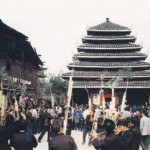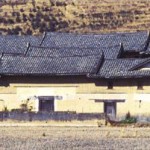View of Chinese vernacular dwelling-3
The Ganlan wood building is the typical storied dwelling, which distributes mostly in the mountains of minority nationalities in the southwest semi-tropical areas. Such a style has pushed the space form and space combination of storied dwelling, the support, suspension and stagger floor along the hills, and, the techniques of mortise and tenon to a very high level. It also demonstrates rich material and spiritual civilizations in combination with the unique national and folk cultures of the minority nationalities.
The traditional typical wood Ganlan buildings are all set up by wood including wood framework, wood purlin, plank wall, bark tile, with tenon and mortise at the link point, without any iron nail or iron hook. The plane of the house is rectangle, while the roof looks like double-slope shape, and the first two to three levels have no walls. The households live closely along the hillside.
In the Dai nationality autonomous counties in Xishuangbanna in the  southwest of Yunnan and De Hong in the west of Yunnan, there are bamboo Ganlan buildings with a kind of bamboo-wood-combined structure using large amount of mao bamboos.
southwest of Yunnan and De Hong in the west of Yunnan, there are bamboo Ganlan buildings with a kind of bamboo-wood-combined structure using large amount of mao bamboos.
Compared with the wood one, the building material of bamboo dwelling are linked mostly by coir rope and 9 rattan; its roof is called Kongming’s Hat with swallowtailed Qianmu – some kind like the Xieshan-style (Roof of the Xieshan-style is composed of two big slopes at front and back and two small slopes at both sides, with two flats in the shape of isosceles triangle also being at both sides of the roof.) four-slope roof. The Jingpo nationality, Jinuo nationality, Hani nationality and other minority nationalities in this area mostly adopt the bamboo dwelling. Their dwellings are alike in terms of the height of overhead level, whether they being paired up with the architecture materials (such as adobe, day lily, the tile top, etc.) and the worshiped totem except for The drum tower at Ma’an Village, Sanjiang County, Guangxi.
The slight differences. There are some other unique features of Yunnan’s bamboo stockaded village, such as the Dais stockaded village, each of which has a well with painstaking decorations around or even with well pavilion or guardian stone-carving beast. Another example is the stockaded village gate of Hani nationality, which is always made of tree trunk and set in the entrance with fur on the cross wood and later bird carving instead. After numerous textual researches, Kenzaburo Torikoshi, the Japanese expert figured out that the traditional torii is derived from Yunnan.
In addition, according to the building origin, fundamental framework and space idea, the Diaojiao building seen in the Mount Emei area in the southwest of Sichuan, Chongqing area and Fenghuang mountainous and lake areas in the west of Hunan Province are all the specific models of storied dwelling. Dwelling in trees and dwelling in caves are both the most original modalities of Chinese traditional vernacular dwelling, which was once concluded by the ancient as “dwelling in trees in the south and caves in the north”. The historical records and archaeological studies have fully proved that the ganlan wood building was once widely adopted in the areas south of Yangtze River, most of which are areas of mountains and hills with the humid, hot and rainy climate, the ecological resource of dense woods, the production mode of paddy cultivations. In ancient times, these regions were known as Yues as a whole. The dwelling culture of Ganlan is the common feature of Yues, and, the totem, courtyard, entrance and the subdivision of structure and materials together with the unique customs of all minorities, were passed on and formed such rich residential dwelling settlements in today’s southern areas especially the southwest.
It is worth mentioning that with the growing population, declining wood resources, the popularization of architectural materials like brick and tile and some other factors, the Han nationality in the south and the minorities in the plains have increasingly farewell the Ganlan wood buildings, and progressed to many variations and new modalities, such as the water street dwelling in Zhejiang Province, the courtyard-style dwelling in Anhui Proivince, the adobe building in the south of Fujian Province, Yi Ke Yin in Kunming and so on.
The Chinese traditional vernacular dwelling always maximizes to comply with nature, or remake nature with compensation. As the polymer of vernacular dwelling, the emergence and development of traditional settlements have fully taken advantage of natural ecological resources while have carefully paid attention to saving the resources, the water scene treatment, fully utilizing the local architectural materials, and making use of the difference in the natural temperature to prevent cold and heat, which has reflected the ecological view attaching importance on partial ecological balance. The dwelling modalities are rich but not miscellaneous, skillful but not factitious because the numerous villagers who created them are accustomed to cultivation and conform to the rule of natural changes. The villagers always attach great importance on the harmony in contrast, the rhyme in gradual change, leading to a strong aesthetic sentiment of rural life with the characteristics as follows:
The Chinese vernacular dwelling is always located at the places near mountains or waters; in the full sunshine or dark shadows; under bright sky or in dense forest . Beauty in nature has another enlightening meaning, that is: the man-made beauty in the Chinese vernacular dwelling is a kind of “meaning modality”.The vernacular dwelling’s appearance, color, sense of reality, light and shadow,etc. closely relate to the function, material and structure of the civilian housing, for example, the horse-head wall for fireproofing, door awning for keeping out rain, the ridge tile for stopping up crack. The components and the decorates of Chinese civilian housing modality adhered to the practical need at the very beginning.
Therefore they are unparalleled by those affected ones for their simple and crude beauty showing their specific original, natural, organic and simple character.– Organic in random, disordered in appearance but implying rule in actuality. The most significant component of all kinds of civilian housing modalities is architectural material. Most rural houses adopt the local materials such as wood on the mountain, soil on the plain, rock on the shoal and grass on the field, which makes each house seem like growing on the land, and become an organic whole with the natural environment. They may be built alongside the mountain, suspend or support when it requires, which can be fully demonstrated by Ganlan wood building. As to the distribution of the housing settlement, it may distribute along the river way if near the river, with the lie of mountain when beside a mountain, concentrate if on plains while scatter if not on plains, which seems disordered, though, contains the rule of “follow the nature”– Harmonious but remaining differences. It is especially suitable for the modality requirements of the dwelling environment. The vernacular dwellings in a region mostly have the similar material, structure and composition of space and flat, forming the same color, sense of reality, appearance and even architectural “symbol”, which indicates the tendency towards coherence of the civilian housing. But such kind of coherence tendency doesn’t mean being totally the same; in fact, there are rich differences in the similar appearance, which can mainly be demonstrated by the combining arrangements of image elements and the subtle changes of the techniques.
It displays the specific characters under the whole harmony of Chinese traditional culture and art, with a strengthening recognizability and high appreciation value. Compared to urban architecture like palace, temple or mansion of high official and scholar, the rural localstyle dwellings, together with such folk customs as slang and ditties, national dresses, local conditions, folk stories and even Da A Fu, cloth tigers, paper-cuts and “sugarcoated haws on a stick”, constitute the so-called popular culture, which emerges, multiplies and develops in the grass-root rural or urban society with its strong vitality. It is created, enjoyed and passed on by the mass, and is close to their life.
It isn’t exaggerated to say that the Chinese local-style dwellings contain the industriousness,wisdom and ideals of most Chinese people, reflecting the history of Chinese nationality. Among the Chinese traditional architectures, there are architectures as magnificent as imperial palaces, mansions, and the ones as elegant as gardens,academies and temples as well, the roots of which – from the mental software to the material hardware – are all unexceptionally based on the vernacular dwellings which possess traditional cultural charm.